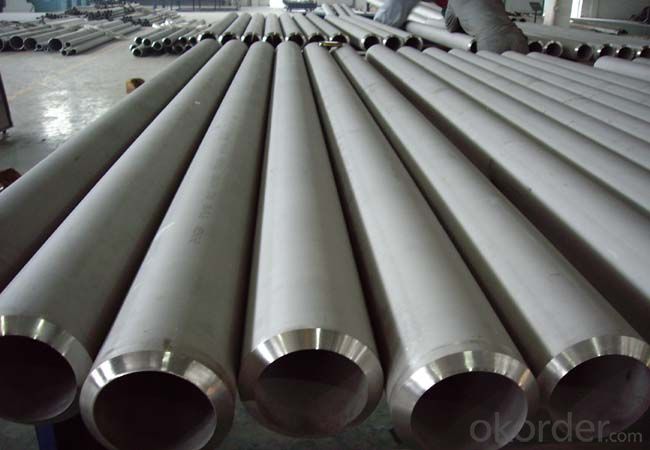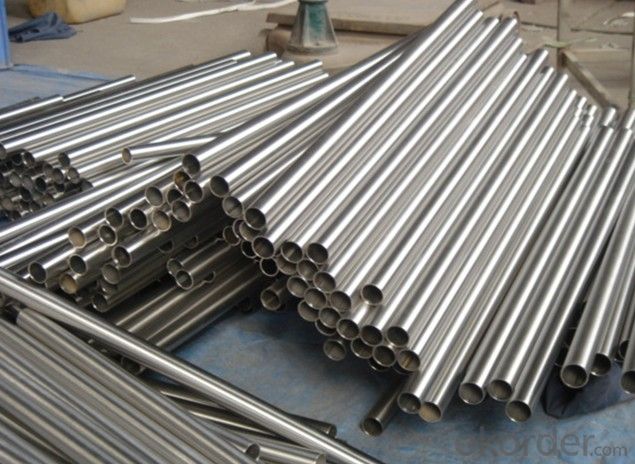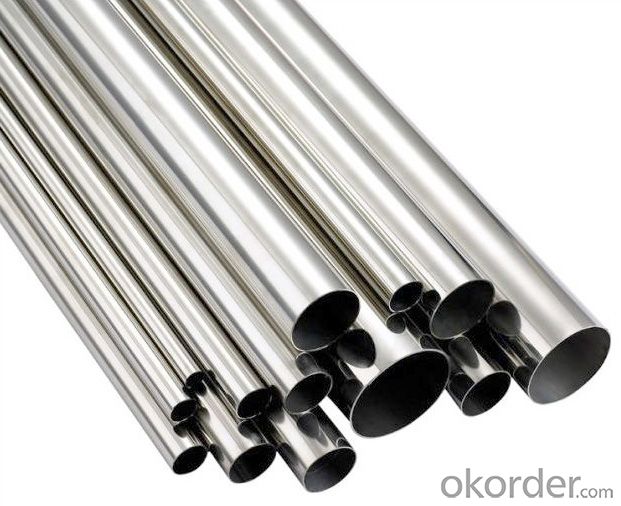Sales of Various Models for the Stainless Steel Pipe
- Loading Port:
- Tianjin
- Payment Terms:
- TT or LC
- Min Order Qty:
- 30 m.t.
- Supply Capability:
- 4000 m.t./month
OKorder Service Pledge
OKorder Financial Service
You Might Also Like
1、Structure of Heat Exchanger Stainless Steel Pipe TP304 ASTM A213 Description:
Boiler Heat Exchange stainless steel pipe is often used in the heating system. Heating system, or those stored energy (such as solar energy) in the form of heat, need to be built with the material that can withstand temperatures up to 550 degrees Celsius. High chromium molybdenum welded steel pipe can work in the extreme, which maintain as the ideal material for the construction of power station.
2、Main Features of Heat Exchanger Stainless Steel Pipe TP304 ASTM A213:
• High manufacturing accuracy
• High strength
• Small inertia resistance
• Strong heat dissipation ability
• Good visual effect
•Reasonable price
3、Heat Exchanger Stainless Steel Pipe TP304 ASTM A213 Specification:
1)Commodity: heat exchanger pipe
2))Material: 304,316L,304L,316,321,310S,etc
3)Thickness:0.5-100mm
4)Length: 1-14m
| Material Grade | 304,304L,316 ,316L,321,310S,2205,904and so on. |
| Standard | ASTM A312, A554, A249, A269 and A270,ect |
| DIN 17456-85 , DIN 17458-85, DIN 17459-92,ect | |
| JIS G3446-1994, JIS G3448-1997, JIS G3459-1997, JIS G3463-1994,ect | |
| GB13296-1991, GB14975-2002, GB14976-2002,ect | |
| Outer Diameter | 13.7-2020mm |
| Thickness | 0.5-50mm |
| Length | 1m -12m or as customers' request |
| Polish | 180G, 320G, 400G Satin / Hairline |
| 400G, 500G, 600G or 800G Mirror finish | |
| Test | eddy current inspection, ultrasonic inspection, X-ray inspection, real-time imaging, hydrostatic test, spectral analysis, intergranular corrosion, water pressure test, and mechanical property testing facilities. |
| Payment | 1) by L/C at sight, |
| 2) 30% deposit, 70% balance before Shipping. | |
| Delivery time | A.7 days if this goods is stock goods. |
| B.25 days if this goods will be produced after order | |
| Validity | Valid time is 3 days for price usually. |
| Payment terms | FOB QINGDAO |
| MOQ | 1 ton |
| Capacity | 1000 ton per month |
| Certificate | ISO, SGS, and third part inspection |
| Applications | the products are widely used in chemical industry, condenser pipe, heat exchanger, petroleum, shipping military, environment protection, high temperature resistant, low temperature resistant, corrosion resistant and so on. |
| packing details | 1) Wooden-box Package. 2) The Wooden Frame Packing. 3) Intertexture Cloth Packaging with the Iron Sheet Bonding and the Two Terminals Covered With Plastic Dome. |
4、Heat Exchanger Stainless Steel Pipe TP304 ASTM A213 Images:



5、FAQ of Heat Exchanger Stainless Steel Pipe TP304 ASTM A213:
①How is the quality of your products?
Our products are manufactured strictly according to national and internaional standard, and we take a test on every pipe before delivered out. If you want see our quality certifications and all kinds of testing report, please just ask us for it.
Guaranteed: If products’ quality don’t accord to discription as we give or the promise before you place order, we promise 100% refund.
②How about price?
Yes, we are factory and be able to give you lowest price below market one, and we have a policy that “ for saving time and absolutely honest business attitude, we quote as lowest as possible for any customer, and discount can be given according to quantity”,if you like bargain and factory price is not low enough as you think, just don’t waste your time.Please trust the quotation we would give you, it is professional one.
③Why should you chose us?
Chose happens because of quality, then price, We can give you both.Additionally, we can also offer professional products inquiry, products knowledge train(for agents), smooth goods delivery, exellent customer solution proposals.Our service formula: good quality+good price+good service=customer’s trust
SGS test is available, customer inspection before shipping is welcome, third party inspection is no problem.
Any question, pls feel free to contact us !
- Q:What is the difference between 904L and 316L stainless steel pipes?
- The composition of 904L and 316L stainless steel pipes sets them apart. 904L contains higher amounts of chromium, nickel, and molybdenum compared to 316L. Specifically, 904L has about 25% nickel and 4.5% molybdenum, while 316L contains approximately 10-14% nickel and 2-3% molybdenum. In terms of corrosion resistance, 904L stainless steel pipes outperform 316L due to their higher chromium, nickel, and molybdenum content. The increased alloying elements make 904L more resistant to localized corrosion, such as pitting and crevice corrosion, particularly in aggressive environments like seawater and acidic conditions. When it comes to strength and toughness, 904L stainless steel pipes have the upper hand over 316L. This makes them more suitable for applications requiring greater mechanical properties, like high-pressure and high-temperature environments. In terms of cost, 904L stainless steel is generally pricier than 316L due to its higher alloying elements. The increased cost is mainly due to the higher nickel and molybdenum content, which are more expensive metals. 316L stainless steel pipes find common usage in various industries, such as food processing, chemical processing, and pharmaceuticals, where corrosion resistance and good mechanical properties are crucial. On the other hand, 904L stainless steel pipes are primarily utilized in highly corrosive environments like offshore platforms, petrochemical plants, and desalination plants, thanks to their exceptional corrosion resistance. In summary, the main distinctions between 904L and 316L stainless steel pipes lie in their composition, corrosion resistance, strength, cost, and applications. While 316L is suitable for general-purpose applications, 904L is preferred in more demanding and corrosive environments.
- Q:Can stainless steel pipes be used for heat exchangers?
- Yes, stainless steel pipes can be used for heat exchangers. Stainless steel is a popular choice for heat exchangers due to its excellent corrosion resistance, high temperature resistance, and durability. It can withstand high pressure and temperature variations, making it suitable for various heat exchange applications. Stainless steel pipes also have good thermal conductivity, allowing for efficient heat transfer. Additionally, stainless steel is easy to clean and maintain, making it a reliable and long-lasting option for heat exchangers in various industries such as chemical, pharmaceutical, food processing, and HVAC.
- Q:How do stainless steel pipes compare to brass pipes?
- Both stainless steel pipes and brass pipes are popular options for plumbing and industrial applications, but they have distinct characteristics that make them suitable for different situations. To begin with, stainless steel pipes are known for their exceptional durability and resistance to corrosion. They can handle high-pressure environments and are highly resistant to rust and corrosion, making them ideal for use in harsh conditions or where water quality is a concern. Additionally, stainless steel pipes have a higher melting point than brass pipes, allowing them to withstand extreme temperatures without compromising their structural integrity. On the other hand, brass pipes are valued for their excellent thermal conductivity and malleability. They are commonly used in plumbing systems because they are easy to bend and shape, providing greater flexibility during installation. Brass pipes also have an appealing aesthetic with their warm, golden color that can enhance the visual appeal of any space. In terms of cost, brass pipes are generally more expensive than stainless steel pipes. However, the longer lifespan and lower maintenance requirements of brass pipes can offset the initial higher cost. Another aspect to consider is the environmental impact. Stainless steel is highly sustainable as it is 100% recyclable, making it an eco-friendly choice. In contrast, brass production requires a significant amount of energy and is less recyclable compared to stainless steel. Ultimately, the choice between stainless steel and brass pipes depends on the specific needs of the project. If durability, corrosion resistance, and long-term reliability are the main considerations, stainless steel pipes are the preferred option. However, if thermal conductivity, malleability, and aesthetic appeal are more important, brass pipes may be the better choice.
- Q:Can stainless steel pipes be used for chemical processing?
- Indeed, chemical processing can indeed utilize stainless steel pipes. One must acknowledge stainless steel's remarkable ability to resist corrosion, rendering it an apt material for handling a diverse range of chemicals. It effectively wards off both organic and inorganic substances, including acids, bases, and salts. Moreover, stainless steel pipes exhibit commendable strength, durability, and resistance to extreme temperatures, enabling them to endure the often severe conditions prevalent in chemical processing. In addition, their ease of maintenance and cleaning renders them a favored choice within the industry. Nevertheless, it remains crucial to carefully consider the specific requirements of the chemicals involved and seek counsel from experts to select the most suitable grade of stainless steel, ensuring optimal performance and safety.
- Q:Can stainless steel pipes be used for nuclear power plants?
- Yes, stainless steel pipes can be used for nuclear power plants. Stainless steel is a commonly used material in the construction of nuclear power plants due to its excellent corrosion resistance and high-temperature strength. These properties are essential for withstanding harsh operating conditions, such as high temperatures and corrosive environments, that are typically present in nuclear power plants. Additionally, stainless steel is known for its durability and long service life, making it a reliable choice for critical applications in the nuclear industry.
- Q:Can stainless steel pipes be used in marine environments?
- Indeed, stainless steel pipes are perfectly suitable for marine environments. With its exceptional resistance to corrosion and rust, stainless steel emerges as the ideal material for marine applications. It can effectively endure the severe conditions of saltwater, including elevated humidity levels, moisture, and exposure to diverse chemicals. Given their durability and enduring performance, stainless steel pipes are extensively utilized in marine vessels, offshore platforms, and various other marine structures. These pipes offer remarkable strength and reliability, even in the face of challenging environments, thus rendering them the preferred choice for marine applications.
- Q:What is the welding of stainless steel?
- Many welding methods, commonly used argon arc welding, less thermal stress, less molten metal elements, forming beautiful; the remaining manual arc welding, higher requirements can be used when laser welding
- Q:Can stainless steel pipes be sandblasted?
- Stainless steel pipes are capable of undergoing sandblasting, which is a widely utilized technique for cleansing, smoothing, or adding texture to the surfaces of various materials, including stainless steel. This method involves expelling fine particles or abrasive substances at high velocities to eliminate impurities or achieve a desired appearance. By means of sandblasting, it is possible to effectively eliminate rust, scale, paint, or other coatings from stainless steel pipes, thereby preparing them for subsequent treatments such as painting or coating. In order to prevent any damage to the stainless steel surface, it is crucial to carefully consider the type and size of abrasive material employed during the sandblasting process. Furthermore, it is essential to adhere to appropriate safety precautions to ensure the protection of workers from the potential hazards associated with sandblasting.
- Q:How do stainless steel pipes perform in extreme weather conditions?
- Stainless steel pipes perform exceptionally well in extreme weather conditions due to their high resistance to corrosion, heat, and cold. They can withstand extreme temperatures, heavy rainfall, snow, and intense sunlight without deteriorating or losing their structural integrity. This makes them a reliable choice for various applications in industries such as oil and gas, construction, and marine environments.
- Q:Are stainless steel pipes suitable for construction projects?
- Yes, stainless steel pipes are highly suitable for construction projects. They offer exceptional strength, durability, and corrosion resistance, making them an ideal choice for various applications in construction, including plumbing, HVAC systems, structural supports, and more. Stainless steel pipes also have excellent aesthetic appeal and can withstand harsh environmental conditions, making them a reliable and long-lasting option for construction projects.
1. Manufacturer Overview |
|
|---|---|
| Location | |
| Year Established | |
| Annual Output Value | |
| Main Markets | |
| Company Certifications | |
2. Manufacturer Certificates |
|
|---|---|
| a) Certification Name | |
| Range | |
| Reference | |
| Validity Period | |
3. Manufacturer Capability |
|
|---|---|
| a)Trade Capacity | |
| Nearest Port | |
| Export Percentage | |
| No.of Employees in Trade Department | |
| Language Spoken: | |
| b)Factory Information | |
| Factory Size: | |
| No. of Production Lines | |
| Contract Manufacturing | |
| Product Price Range | |
Send your message to us
Sales of Various Models for the Stainless Steel Pipe
- Loading Port:
- Tianjin
- Payment Terms:
- TT or LC
- Min Order Qty:
- 30 m.t.
- Supply Capability:
- 4000 m.t./month
OKorder Service Pledge
OKorder Financial Service
Similar products
New products
Hot products
Hot Searches
Related keywords





























